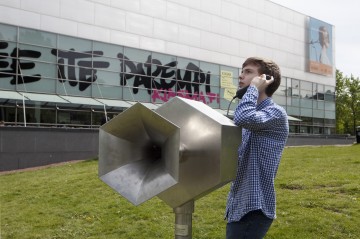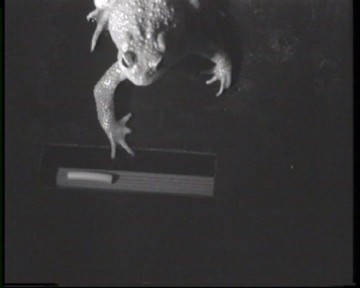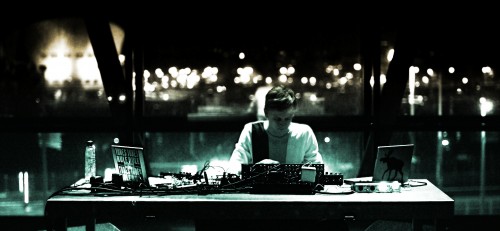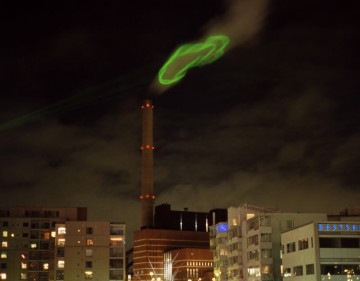One of the best exhibitions I saw in Helsinki this summer was at Galleria Heino, a small space on the hip street Uudenmaankatu. On the recommendation of an artist friend, I went to see Mika Taanila’s show, Installations. Taanila is a moving image artist working with both film and video. For over twenty years, he has created a body of work —short and long, narrative and experimental — that looks at technological evolution and the intersection of art and science in particular. I first discovered Taanila when I saw his documentary about the electronic music pioneer Erkki Kurenniemi, The Future Is Not What It Used To Be (2002), in Arctic Hysteria, a recent historical survey of Finnish contemporary art at Taidehalli (Helsinki’s kunsthalle) in 2009. At Galleria Heino, ironically, part of Taanila’s show was out of order; one of the two installations was “broken” the day I went. Ultimately, it didn’t much matter for what I did see allowed me to consider Finnish contemporary cultural practices’ address of technology on a broader scale.
The Zone of Total Eclipse (2006) – Mika Taanila from mediateletipos on Vimeo.
Taanila’s video installation that was functioning, Twilight (2010), consisted of two old-school video projectors mounted on rails on the gallery floor, slowly traveling back and forth across the diameter of the space and repeating the same linear movement in an endless loop. These projectors threw a large doubled image on the wall: a grainy, barely moving portrait of a single laboratory toad looking for worms. Taanila’s clever formal and conceptual doubling of the projectors, as well as the natural and the synthetic — the use of technology to view the “natural” world of the toad in the lab and, conversely, viewing the natural world in a way making one hyper-aware of the technology involved —was, if you were patient enough to pick up on the snail-paced moving projectors, rather sublime. Taanila, in the show’s press release, likens both the toads and the conveyer belt rails to the cycle of light — “the waiting, the reward, the light, the darkness.” Recalling the materialist and time-based concerns of structuralist filmmaking as well as more recent forays into artists’ cinema involving projectors (think Tacita Dean and Rodney Graham), the installation allows the viewer a phenomenological experience of the work itself.
Continuing Taanila’s interest in merging humans and machines, the exhibition points to the ceaseless presence of technology, as both aid and passive witness, in our everyday lives. My experience of Taanila’s exhibition reinforced stereotypes of Finland’s technological prowess (Nokia, anyone?), but in a good way. These could be, like Taanila’s installation, purposely archaic and paying homage to a simpler techno-era (think the synthesizer-jams of Pan Sonic and Vladislav Delay). Or they can be more generative, I thought — which brings me to Pixelache, a real-life activist translation of Taanila’s phenomeno-formalist investigations.
Pikseliähky, or Pixelache, is an organization, festival, and worldwide network with a permanent hub online via an ever-evolving website. Or websites, more accurately; the organization maintains a seemingly endless rabbit-hole of well-designed festival sites, blogs, wikis, Vimeo videos, Flickr streams, Twitter feeds, and so on. I gather, however, that this is part of Pixelache’s blanket serve-mankind-through-technology-while-still-remaining-critical stance, and social networking plays a large role in its efficacy.
At Pixelache’s office (previously near Galleria Heino; now situated in the Cable Factory), over wild Finnish blueberries and the ubiquitous cup of rocket fuel coffee found city-wide, festival coordinator Nathalie Aubret shed light on the organization’s complex, rhizomatic structure. Founded in 2002 by artist and organizer Juha Huuskonen and run by the parent organization Piknik Frequency, Pixelache is an annual festival of electronic art and subcultures taking place in Helsinki each spring. Aubret explains that the first Pixelache event was put together in an improvised manner, with a tiny budget of a couple hundred euros. The purpose was to bring local active people together to discuss and present experimental work that fell between disciplines — not just art, design, or research, but all of these at the same time. There was no forum showing this type of work in Helsinki at the time, so Pixelache seized the opportunity.
In its current iteration, the festival offers several days of myriad events, workshops, exhibitions, installations, and performances that both experiment with and take a critical approach to media and technology (the 2010 installment alone offered 21 projects conceived for and instituted at the festival). In addition, Pixelache offers year-round educational offerings through its “Pixelversity.” Also of note here is that Pixelache Helsinki has spawned an international network of like-minded affiliates. These include Mal au Pixel (Paris), Pixelvärk (Stockholm), Piksel (Bergen), Pikslaverk (Reykjavik), Pixelazo (Colombia), Afropixel (Dakar) and PixelIST (Istanbul). For the sake of brevity, I won’t go into those organizations here but their vastness and diversity is testament to the cross-cultural relevance of the Helsinki branch’s interests and concerns. As Aubret notes, the common interests and values that are shared are what matters. There are also recurring themes across festivals and “nodes”: public space/locative media/borderline between physical and virtual space, do-it-yourself/hacking/mis-using technologies, organizational strategies/collaboration/democracy, etc.
Comprehensive in its support, encouragement, and questioning of technology and the media arts, Pixelache focuses on five subject areas of particular interest: experimental interaction and electronics; VJ culture and audiovisual performances; grassroots organizing and networks; politics and economics of media/technology; and media literacy and environmental issues. While the offerings in these categories are vast and varied each year, recently, these took the forms of:
- Artist residencies, during which artists create new work that is then exhibited at the festival;
- Software of the year awards;
- Signals from the South, a program organized around grassroots development in media arts in the Global South (South America, Africa, Asia);
- Spaceship Earth, a workshop, a seminar and an exhibition exploring Buckminster Fuller’s ideas of sustainable living through natural resources;
- Audiovisual Hacking workshops, using discarded electronic parts;
- A Live Video Lab, featuring various performances around the current state of live visuals/performance/VJ culture;
- Presentations by various academic robotics, art and design, and networked media research labs from Rotterdam, Gothenburg, and Pittsburgh;
- A self-sufficient, self-explanatory party container;
- A public art project competition on the theme of energy consumption;
- The Finnish-Latvian Herbologies/Foraging Network, a series of programs exploring the intersection of herbs and medicinal plants and open-source networks and technologies, including the creation of a temporary Window Farm at Kiasma, Helsinki’s Museum of Contemporary Art;
- An exhibition of work by artist Golan Levin, also at Kiasma;
And the list goes on. For a full list of the 2010 offerings, visit https://www.pixelache.ac/helsinki/festival-2010.

Unsworn Industries, Megaphonebooth at Kiasma-nurmi, 2010. Courtesy Finnish National Gallery / Central Art Archives / Ella Tommila.
Some of my favorite projects in recent Pixelache history include Unsworn Industries’ Megaphonebooth, a giant, coin-operated megaphone in Kiasma’s courtyard. For €1/minute, you can speak into the handset and your voice is amplified megaphone-style. The project is a critique of how we already engage technology in public space through cell phones, iPods, and the like, and how technology in turn messages us through advertising and telemarketing. Both scenarios take place often to the detriment of our fellow public space users. Megaphonebooth, explain its Swedish designers, “is a deliberately tragic solution meant to bring focus to an unbalance while feebly attempting to correct it.” Entirely different but equally memorable as a Pixelache project was the widely successful Nuage Vert (2008), now inspiration for this year’s energy consumption-themed public art contest. An artwork by HeHe (Helen Evans & Heiko Hansen), Nuage Vert harnessed the vapor emissions of a Helsinki power plant to illustrate the current levels of electricity consumption by local residents in the sky itself. The project received the coveted Golden Nica award at Ars Electronica and was named Finnish Environmental Artwork of the Year in 2008.
For a young new media organization, Pixelache is impressively organized. On its internal wiki, you can download annual reports of its festivals and affiliates’ activities. From these, I learned that the organization runs on a budget of about €75,000, only a fraction of which is earned income from ticket sales. The lion’s share comes from funding from the Finnish Ministry of Culture, Helsinki City Cultural Office, AVEK Promotion Centre for Audiovisual Culture, and the Finnish Arts Council. The Museum of Contemporary Art Kiasma, where the festival is centered, numerous international embassies and consulates, and the Ministry of Foreign Affairs also support Pixelache in various ways to bring in artists and provide spaces for them to create, perform, and interact with the public. All of the Helsinki office’s work is undertaken by a staff of five, including Huuskonen and Aubret.
From this overload of information, I began to think of Pixelache not just as a festival, organization, university, or network, but as an international, cross-cultural, cross-medium ethos. Sure, it offers your standard new media arts festival offerings — demos, VJ performances, exhibitions, parties, and the like — but it is no Transmediale or Ars Electronica. One of the more surprising elements to me is the close attention Pixelache pays to green issues. From the grassroots activism of some of its more peripheral arms, which are grappling with economical and environmental sustainability, to offering workshops on alternative economical models, Pixelache is looking at ecology in the broadest sense: both how the planet affects us and how we impact the planet. But it also considers how we ourselves, our technological aids, artwork, activism, and even our e-waste are all bound up in a larger McLuhan-esque ecological system networking cause and effect, regulation and revolution. I find this self-reflexivity highly unusual but then again, Pixelache isn’t your average arts organization or festival.
While Mika Taanila has not collaborated directly with Pixelache or participated in its festivals, to me, his work functions as the flip side of the same conceptual coin. Whereas Taanila mines the recent history of technology, investigating its objects and makers in hopes of gleaning insights about our contemporary condition, Pixelache looks to current practitioners for clues as to where the electronic arts are headed and how we can responsibly, sustainably move forward. Together, Taanila and Pixelache remind us of where we took technology, and where it will possibly take us.
The 10th edition of Pixelache Helsinki festival will take place between 10-13 March 2011. It recently announced the first of the 2011 offerings, including projects related to mapping; computational photography; and world transformation through culture, gardening and technology. Visit www.pixelache.ac/helsinki.






